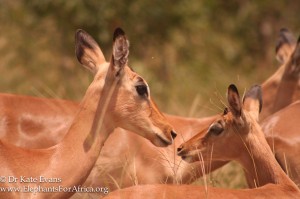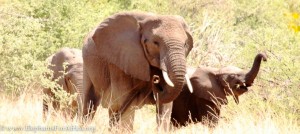A day in the life of a researcher
November 24, 2009Pula! (rain)
January 6, 2010Poop to tell the tale

0530 and the alarm ring joined the sounds of the dawn chorus and roused me out of deep sleep. My motivation to get up and go out was at a bit of a low as for the past 3 days I had not seen any elephants, but I managed to get out of bed, load the car, make a cup of tea and be on the at 0600.
 Today I drive route 3, which takes me south a camp. I say good morning to the herd of Impala and Zebra that are often outside of camp – congratulating the females on the safe arrive of their babies and wishing them well. A couple of the Zebra’s are about to pop and a few more of the impala’s too. They are just the cutest things, and after the harshness of the flood (I know it sounds ironic, but with all the water around the vegetation takes a hammering as everything is forced into smaller and smaller areas) and dry seasons, it is wonderful to see new life again. As I pass the truck road Baobab, and note that the elephants have been really nailing this one as well as the others in the area, I come across a small herd of elephant, I notice a young male at first – feeding out on the open floodplain, a females backside pocks out from the forest behind him, I slowly move forward and wait for them to come through the forest, which they do. The 2 elephants I had seen morph into a herd of 9 – 2 large females and their young. I climb on top of the roof for a better look and to get some ID photos. They are relaxed and unperturbed by me taking photos and frantically taking notes, and drawing ID’s.
Today I drive route 3, which takes me south a camp. I say good morning to the herd of Impala and Zebra that are often outside of camp – congratulating the females on the safe arrive of their babies and wishing them well. A couple of the Zebra’s are about to pop and a few more of the impala’s too. They are just the cutest things, and after the harshness of the flood (I know it sounds ironic, but with all the water around the vegetation takes a hammering as everything is forced into smaller and smaller areas) and dry seasons, it is wonderful to see new life again. As I pass the truck road Baobab, and note that the elephants have been really nailing this one as well as the others in the area, I come across a small herd of elephant, I notice a young male at first – feeding out on the open floodplain, a females backside pocks out from the forest behind him, I slowly move forward and wait for them to come through the forest, which they do. The 2 elephants I had seen morph into a herd of 9 – 2 large females and their young. I climb on top of the roof for a better look and to get some ID photos. They are relaxed and unperturbed by me taking photos and frantically taking notes, and drawing ID’s.
 One adult female comes right passed the car, with her new born tight by her side, her 2 older calf follow behind, a little more wary of me. I spend an hour with them, hoping the young male with defecate, so I can add his sample to our hormone and behavioural research database, but no luck. Eventually the two large females go their separate ways with their young and I lose them. I follow one out across the floodplain to the east and they join up with 5 males and an old female which I had not noticed in the distance. The males are busy feeding on the palm, Phoenix reclinata, and the female is stood by the largest male. I cannot tell who the male is as his head is in the island, his body on the floodplain.
One adult female comes right passed the car, with her new born tight by her side, her 2 older calf follow behind, a little more wary of me. I spend an hour with them, hoping the young male with defecate, so I can add his sample to our hormone and behavioural research database, but no luck. Eventually the two large females go their separate ways with their young and I lose them. I follow one out across the floodplain to the east and they join up with 5 males and an old female which I had not noticed in the distance. The males are busy feeding on the palm, Phoenix reclinata, and the female is stood by the largest male. I cannot tell who the male is as his head is in the island, his body on the floodplain.
I wonder why this female is alone, where is the rest of the herd? Is she in oestrous and he in musth?
I get on with identifying the other males, and soon the large male emerges from the island and tells me all I need to know – he is in full blown musth. He is secreting from his temporal glands, his penis sheath is green and he is dribbling urine (the female had been standing in front of him so I could not see what was going on down there). I am still perplexed by the female choosing to be with the males, rather than the males join the herd; which is the norm?
I soon get a possible answer, when the female moves, she is crippled – her front right leg badly swollen and wonky. I know this female, I have seen her before, and amazingly she is still going strong. Perhaps, she has slowed up a little and unable to keep up with the other females!!! I do not know, but she seemed happy to be with the males, with them all interested in her, I guess it must feel nice to be the centre of attention for a while!!!!!! After an hour and a half I can no longer follow them as they have crossed a river channel.
Three of the males have defecated and I collected them or the hormone and parasite study.
I finish the route and get on with processing the samples – I will have to wait for the much anticipated result, but hopefully to provide more important data to answer the questions on male elephants and what they need for their future conservation.
